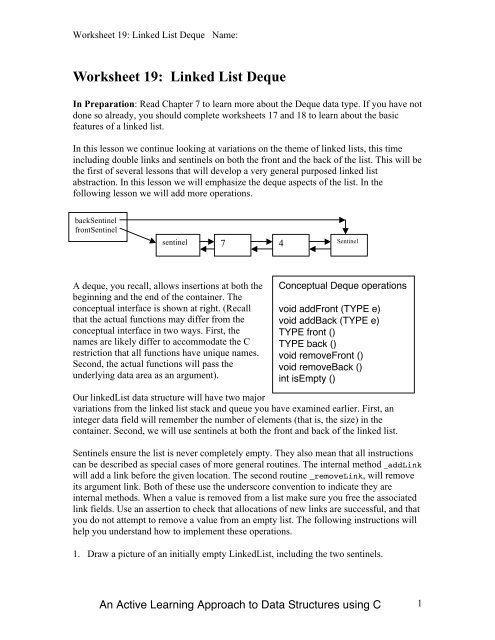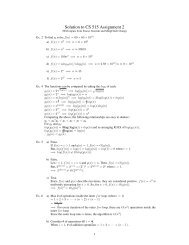Worksheet 19: Linked List Deque - Classes
Worksheet 19: Linked List Deque - Classes
Worksheet 19: Linked List Deque - Classes
You also want an ePaper? Increase the reach of your titles
YUMPU automatically turns print PDFs into web optimized ePapers that Google loves.
<strong>Worksheet</strong> <strong>19</strong>: <strong>Linked</strong> <strong>List</strong> <strong>Deque</strong> Name:<br />
<strong>Worksheet</strong> <strong>19</strong>: <strong>Linked</strong> <strong>List</strong> <strong>Deque</strong><br />
In Preparation: Read Chapter 7 to learn more about the <strong>Deque</strong> data type. If you have not<br />
done so already, you should complete worksheets 17 and 18 to learn about the basic<br />
features of a linked list.<br />
In this lesson we continue looking at variations on the theme of linked lists, this time<br />
including double links and sentinels on both the front and the back of the list. This will be<br />
the first of several lessons that will develop a very general purposed linked list<br />
abstraction. In this lesson we will emphasize the deque aspects of the list. In the<br />
following lesson we will add more operations.<br />
backSentinel<br />
frontSentinel<br />
sentinel 7 4<br />
Sentinel<br />
A deque, you recall, allows insertions at both the<br />
beginning and the end of the container. The<br />
conceptual interface is shown at right. (Recall<br />
that the actual functions may differ from the<br />
conceptual interface in two ways. First, the<br />
names are likely differ to accommodate the C<br />
restriction that all functions have unique names.<br />
Second, the actual functions will pass the<br />
underlying data area as an argument).<br />
Conceptual <strong>Deque</strong> operations<br />
void addFront (TYPE e)<br />
void addBack (TYPE e)<br />
TYPE front ()<br />
TYPE back ()<br />
void removeFront ()<br />
void removeBack ()<br />
int isEmpty ()<br />
Our linked<strong>List</strong> data structure will have two major<br />
variations from the linked list stack and queue you have examined earlier. First, an<br />
integer data field will remember the number of elements (that is, the size) in the<br />
container. Second, we will use sentinels at both the front and back of the linked list.<br />
Sentinels ensure the list is never completely empty. They also mean that all instructions<br />
can be described as special cases of more general routines. The internal method _addLink<br />
will add a link before the given location. The second routine _removeLink, will remove<br />
its argument link. Both of these use the underscore convention to indicate they are<br />
internal methods. When a value is removed from a list make sure you free the associated<br />
link fields. Use an assertion to check that allocations of new links are successful, and that<br />
you do not attempt to remove a value from an empty list. The following instructions will<br />
help you understand how to implement these operations.<br />
1. Draw a picture of an initially empty <strong>Linked</strong><strong>List</strong>, including the two sentinels.<br />
An Active Learning Approach to Data Structures using C 1
<strong>Worksheet</strong> <strong>19</strong>: <strong>Linked</strong> <strong>List</strong> <strong>Deque</strong> Name:<br />
2. Draw a picture of the <strong>Linked</strong><strong>List</strong> after the insertion of one value.<br />
3. Based on the previous two pictures, can you describe what property characterizes an<br />
empty collection?<br />
4. Draw a picture of a <strong>Linked</strong><strong>List</strong> with three or more values (in addition to the<br />
sentenals).<br />
5. Draw a picture after a value has been inserted into the front of the collection. Notice<br />
that this is between the front sentinal and the following element. Draw a picture<br />
showing an insertion into the back. Notice that this is again between the last element<br />
and the ending sentinel. Abstracting from these pictures, what would the function<br />
addBefore need to do, where the argument is the link that will follow the location in<br />
which the value is inserted.<br />
6. Draw a picture of a linked<strong>List</strong> with three or more values, then examine what is<br />
needed to remove both the first and the last element. Can you see how both of these<br />
operations can be implemented as a call on a common operation, called removeLink?<br />
7. What is the algorithmic complexity of each of the deque operations?<br />
An Active Learning Approach to Data Structures using C 2
<strong>Worksheet</strong> <strong>19</strong>: <strong>Linked</strong> <strong>List</strong> <strong>Deque</strong> Name:<br />
struct dlink {<br />
TYPE value;<br />
struct dlink * next;<br />
struct dlink * prev;<br />
};<br />
struct linked<strong>List</strong> {<br />
int size;<br />
struct dlink * frontSentinel;<br />
struct dlink * backSentinel;<br />
};<br />
/* these functions are written for you */<br />
void <strong>Linked</strong><strong>List</strong>Init (struct linked<strong>List</strong> *q) {<br />
q->frontSentinel = (struct dlink *) malloc(sizeof(struct dlink));<br />
assert(q->frontSentinel != 0);<br />
q->backSentinel = (struct dlink *) malloc(sizeof(struct dlink));<br />
assert(q->backSentinel);<br />
q->frontSentinel->next = q->backSentinel;<br />
q->backSentinel->prev = q->frontSentinal;<br />
q->size = 0;<br />
}<br />
void linked<strong>List</strong>Free (struct linked<strong>List</strong> *q) {<br />
while (q->size > 0)<br />
linked<strong>List</strong>RemoveFront(q);<br />
free (q->frontSentinel);<br />
free (q->backSsentinel);<br />
q->frontSentinel = q->backSentinel = null;<br />
}<br />
void <strong>Linked</strong><strong>List</strong>AddFront (struct linked<strong>List</strong> *q, TYPE e)<br />
{ _addLink(q, q->frontSentinel_>next, e); }<br />
void <strong>Linked</strong><strong>List</strong>Addback (struct linked<strong>List</strong> *q, TYPE e)<br />
{ _addLink(q, q->backSentinel, e); }<br />
void linked<strong>List</strong>RemoveFront (struct linked<strong>List</strong> *q) {<br />
assert(! linked<strong>List</strong>IsEmpty(q));<br />
_removeLink (q, q->frontSentinal->next);<br />
}<br />
void <strong>Linked</strong><strong>List</strong>RemoveBack (struct linked<strong>List</strong> *q) {<br />
assert(! linked<strong>List</strong>IsEmpty(q));<br />
_removeLink (q, q->backSentinel->prev);<br />
}<br />
int <strong>Linked</strong><strong>List</strong>IsEmpty (struct linked<strong>List</strong> *q) {<br />
return q->size == 0;<br />
}<br />
An Active Learning Approach to Data Structures using C 3
<strong>Worksheet</strong> <strong>19</strong>: <strong>Linked</strong> <strong>List</strong> <strong>Deque</strong> Name:<br />
/* write addLink and removeLink. Make sure they update the size field correctly */<br />
/* _addLink places a new link BEFORE the provide link, lnk */<br />
void _addLink (struct linked<strong>List</strong> *q, struct dlink *lnk, TYPE e) {<br />
}<br />
void _removeLink (struct linked<strong>List</strong> *q, struct dlink *lnk) {<br />
}<br />
TYPE <strong>Linked</strong><strong>List</strong>Front (struct linked<strong>List</strong> *q) {<br />
}<br />
TYPE <strong>Linked</strong><strong>List</strong>Back (struct linked<strong>List</strong> *q) {<br />
}<br />
An Active Learning Approach to Data Structures using C 4

















